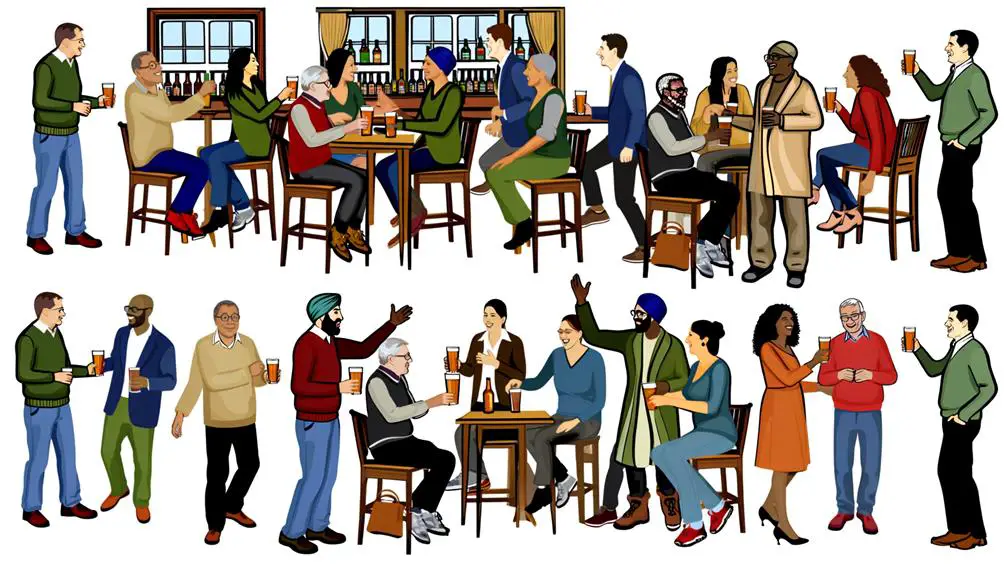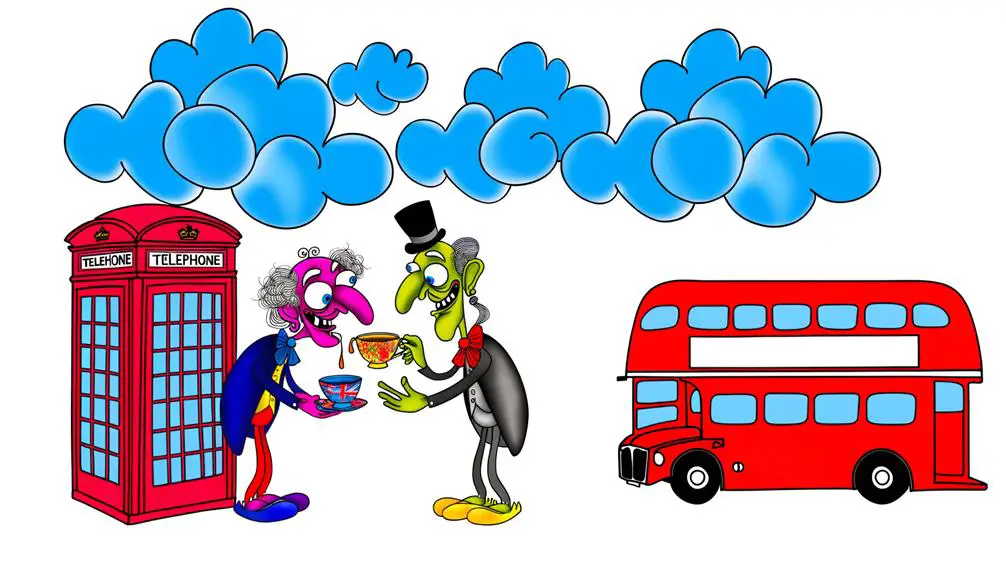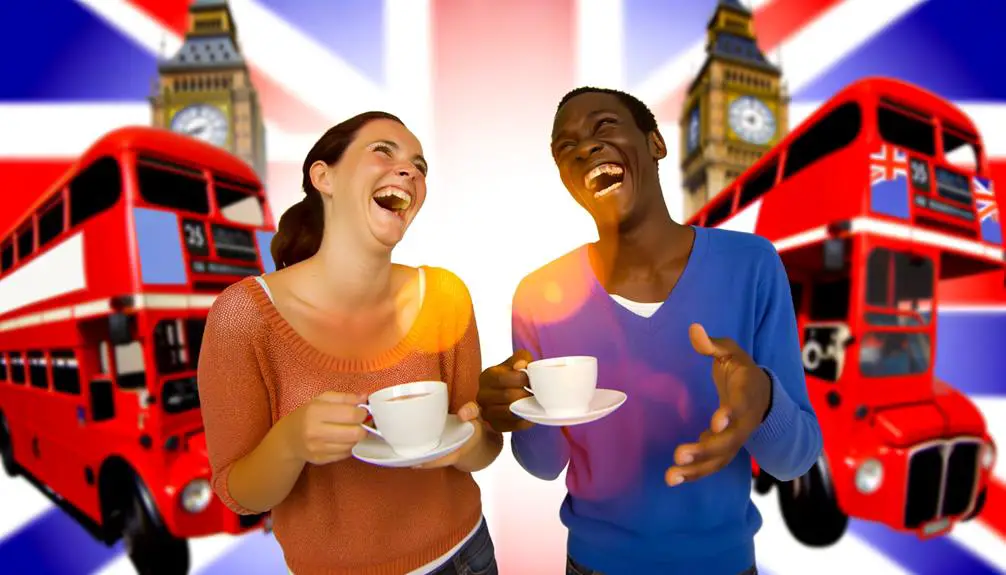In British slang, "banter" refers to a form of social interaction characterized by playful and teasing remarks that exhibit a deep-rooted understanding of irony, sarcasm, and quick wit. It's an intellectual exercise in humor, requiring sophistication in conversational jesting, and acts as a social lubricant, fostering unity and camaraderie among groups. Rooted in medieval traditions of court jesters and enriched by centuries of linguistic evolution and cultural influences, banter today is a hallmark of British communication. It straddles the line between camaraderie and discomfort, demanding adeptness in language and a keen sensitivity to social dynamics. As you explore further, you'll discover the intricate balance this tradition maintains within social cohesion and individual expression.
Key Takeaways
- Banter in British slang refers to playful, teasing conversation meant to amuse both parties.
- It relies heavily on irony, sarcasm, and quick-witted responses for humor.
- Considered an essential part of social interaction, fostering camaraderie and unity.
- Requires a high level of linguistic adeptness and understanding of social cues.
- It's distinguished from bullying by mutual respect and the intent to bond rather than harm.
The Essence of Banter

At its core, banter is a form of social interaction where playful, teasing remarks are exchanged, often testing the boundaries of camaraderie and wit. This practice, while universal in its essence, exhibits significant international variations, shaped profoundly by cultural perceptions. In analyzing the essence of banter, it's essential to recognize these variations as reflections of societal norms and values. For instance, what might be considered harmless banter in one culture could be perceived as overtly aggressive or even offensive in another. This divergence underscores the importance of understanding the nuanced dynamics of social interactions across different cultural landscapes.
Furthermore, the role of cultural perceptions in shaping the practices and acceptance of banter cannot be overemphasized. Societies with a high value on directness and transparency might foster a bantering style that is more blunt, while cultures that prioritize harmony and indirect communication often engage in a subtler form of banter. These distinctions highlight the adaptive nature of banter, molding itself to fit the communicative conventions and social etiquettes of each culture. Therefore, a scholarly analysis of banter reveals it as a complex, multifaceted form of social exchange, deeply entwined with cultural identities and interpersonal dynamics.
Historical Roots of Banter
Delving into the historical roots of banter, it's important to understand that its origins are as ancient as human social interaction itself, reflecting the evolving nuances of communal rapport and wit through ages. The journey of banter from a mere form of verbal exchange to a nuanced element of British culture is a proof of both linguistic evolution and cultural comparisons. To better grasp this evolution, consider the following:
- Early Beginnings: The concept of banter has roots in the medieval period, where it was often seen in the playful exchanges among court jesters and their audiences. This period highlights the infancy of banter as a recognized form of social interaction, laying the groundwork for its linguistic evolution.
- Cultural Infusion: As trade routes expanded and cultures intermingled, so did the complexities of language and humor. This cross-cultural exchange enriched the English language, introducing new forms of wit and repartee that contributed to the depth of banter seen today.
- Modern Adaptation: In contemporary times, banter has become a hallmark of British social interaction, reflecting centuries of linguistic shaping and cultural influences. Its ability to convey camaraderie, while also engaging in the fine line of sarcasm and humor, showcases the intricate dance between language and societal norms.
These points highlight the rich tapestry of history and cultural comparisons that have shaped the linguistic evolution of banter into what it is today.
Characteristics of British Banter

You'll find that the essence of British banter hinges on its witty exchange elements, which demand a quick intellect and a keen sense of timing. This form of communication serves a critical role in social bonding, fostering a sense of unity and camaraderie among participants. By examining these characteristics, one gains insight into the complex social dynamics that banter encapsulates within British culture.
Witty Exchange Elements
British banter, characterized by its witty exchange elements, often hinges on the adept use of irony and sarcasm, creating a dynamic interplay that's both intellectually stimulating and humorously engaging. This verbal sparring showcases the intricate humor dynamics fundamental to British social interaction. To understand the essence, consider the following:
- Irony as a Foundation: The ability to say one thing while meaning another, often in a humorous or mildly sardonic manner, serves as the bedrock of banter.
- Sarcasm for Depth: Sarcasm adds layers, allowing for nuanced exchanges that test both the speaker's wit and the listener's comprehension.
- Quick-Witted Responses: The hallmark of British banter is the rapid-fire delivery of retorts, requiring participants to be alert and ready to engage intellectually.
Analyzing these elements reveals the sophistication embedded in what might otherwise appear as simple conversational jesting.
Social Bonding Role
Banter's role in social bonding among Britons cannot be understated, as it serves as a complex mechanism that fosters a sense of unity and camaraderie through shared humor and linguistic dexterity. This unique form of communication reflects broad cultural perspectives, highlighting significant humor differences when compared to other societies. Its nuanced nature demands an intricate understanding, enabling individuals to navigate social interactions effectively.
| Aspect | Description |
|---|---|
| Cultural Context | Deeply rooted in British culture, embodying humor differences and promoting social cohesion. |
| Linguistic Skill | Requires adeptness in language, showcasing the speaker's wit and intelligence. |
| Social Function | Acts as a social lubricant, facilitating connections and reinforcing group identities. |
This analysis underscores banter's pivotal role in British social dynamics, illustrating its contribution to building and maintaining relationships.
Banter Vs. Bullying
In dissecting the nuanced distinction between banter and bullying, it's important to recognize that the former hinges on mutual understanding and respect, whereas the latter is characterized by an essential imbalance of power and an intent to harm. This differentiation is not merely semantic but is deeply rooted in cultural sensitivity and the awareness of power dynamics within social interactions. To fully grasp the complexity of this distinction, consider the following:
- Mutual Respect vs. Harm: Banter relies on a foundation of mutual respect and understanding, often serving as a form of social bonding. Conversely, bullying lacks this foundation and is aimed at causing harm or asserting dominance.
- Cultural Sensitivity: Understanding the cultural context is paramount. What might be considered light-hearted banter in one culture could be viewed as offensive in another, highlighting the importance of cultural sensitivity in these interactions.
- Power Dynamics: The dynamics of power play an essential role. Banter is an exchange between equals, whereas bullying is an exertion of power by one individual over another, often exploiting perceived vulnerabilities.
Understanding these distinctions requires not just an awareness of the words used but also an appreciation for the complex social cues and contexts in which they are employed.
The Social Role of Banter

You'll find that banter plays a pivotal role in the fabric of British social interactions, serving as a tool for bonding through playful teasing. It intricately navigates social hierarchies, subtly reinforcing or challenging them without overt confrontation. However, understanding the limits of social banter is essential, as it treads a fine line between camaraderie and discomfort.
Bonding Through Playful Teasing
At its core, banter serves as a dynamic tool for social bonding, often utilizing playful teasing to strengthen interpersonal connections among individuals. This facet of communication is intricately woven with teasing techniques and cultural nuances that highlight its importance and utility in fostering relationships.
- Teasing Techniques: These involve a delicate balance between humor and respect, ensuring that the playful mockery strengthens rather than harms the bond.
- Cultural Nuances: Understanding the fine line in different cultures, particularly British, is essential. What is considered playful in one culture might be offensive in another, making cultural literacy a key component of effective banter.
- Interpersonal Connections: Through the shared laughter and light-hearted exchanges, individuals find common ground, thereby deepening their rapport and mutual understanding.
Analyzing banter in this light reveals its significance in social interactions, highlighting its role beyond mere entertainment.
Navigating Social Hierarchies
Having explored how banter fosters interpersonal connections through playful teasing, it's now important to understand how it also navigates and reflects social hierarchies within various social settings. Banter operates within a nuanced framework, engaging with formal etiquette and cultural sensitivity to maintain harmony. It's a delicate balancing act, recognizing and respecting the lines dictated by social ranks and relationships.
| Aspect | Role in Banter | Importance |
|---|---|---|
| Formal Etiquette | Guides acceptable topics | High |
| Cultural Sensitivity | Prevents misunderstandings | Critical |
| Social Hierarchy | Dictates dynamics | Significant |
| Relationship Closeness | Modulates intensity | Varied |
| Context | Influences appropriateness | Key |
This structured approach to banter ensures that it contributes positively to social cohesion, subtly reinforcing or challenging existing hierarchies without causing discord.
Limits of Social Banter
Why is it that despite its seemingly inclusive nature, social banter inherently possesses limitations that shape its role within interpersonal and group dynamics? The constraints are multifaceted, driven by:
- Cultural Sensitivity: Not everyone shares the same background or sense of humor. What's considered light-hearted in one culture may be offensive in another, necessitating a nuanced understanding of cultural norms.
- Legal Implications: In the workplace, what starts as banter can inadvertently cross into harassment, leading to legal repercussions for individuals and organizations.
- Social Dynamics: The balance of power in relationships influences the reception and impact of banter. It's essential to understand social hierarchies to avoid perpetuating inequalities or causing unintended harm.
These factors underscore the importance of handling social banter with awareness and intentionality.
Mastering the Art of Banter

To excel in the art of banter, it is vital to cultivate a sharp understanding of both the linguistic subtleties and the cultural contexts in which this form of communication thrives. Banter, a nuanced form of verbal play, requires a delicate balance between humor and respect, making *banter etiquette* an essential component to master. This etiquette is not universal; rather, it is deeply embedded within specific *cultural differences*, highlighting the importance of context in the effective deployment of banter. For instance, what constitutes as playful banter in one culture may be perceived as rude or inappropriate in another, underscoring the need for cultural sensitivity and awareness.
Mastering banter involves more than just quick wit or the ability to make others laugh. It's about understanding the boundaries of social interaction, recognizing the timing and appropriateness of jest, and, most importantly, ensuring that the exchange remains enjoyable for all parties involved. The artful banterer knows when to advance and when to retreat, maintaining a harmonious balance between assertiveness and receptivity. Therefore, to truly excel, one must not only be adept in the mechanics of language but also in the dynamics of social interplay, weaving together linguistic dexterity with cultural intelligence.
Common Misunderstandings
Despite its playful nature, banter often leads to common misunderstandings, primarily due to the thin line it treads between humor and offense. Cultural perceptions and language barriers further complicate its interpretation, leading to a nuanced terrain where what is considered light-hearted in one context may be viewed as insensitive in another. This complexity is rooted in several factors:
- Cultural Perceptions: What is deemed as acceptable banter in British culture might not translate well into other cultures. The British penchant for self-deprecation and irony can be misconstrued as rudeness or lack of confidence by those unacquainted with these nuances. This disparity in cultural norms often leads to misunderstandings when the intent behind the words is lost in translation.
- Language Barriers: Non-native speakers may find the subtleties of banter challenging to grasp. The playful use of language, which relies heavily on tone, context, and knowledge of local idioms, can lead to confusion. Misinterpretations are common when the linguistic cues that signal banter are missed or misunderstood.
- Sensitivity to Context: The appropriateness of banter often hinges on the relationship between the individuals involved and the setting in which it occurs. What is considered humorous in a close-knit group may not be well-received in a more formal context, leading to awkwardness or offense.
Understanding these layers is important for maneuvering the complexities of banter without falling into the trap of common misunderstandings.
Banter in British Media

Understanding the subtleties of banter becomes particularly intriguing when examining its portrayal and reception in British media. This domain, saturated with both scripted and spontaneous exchanges, serves as a fertile ground for exploring how banter, distilled through media stereotypes, impacts public perception. The nuanced use of banter in British television, particularly in panel shows and sitcoms, offers a rich tapestry for analysis. These platforms frequently utilize banter as a narrative device, highlighting the cultural embrace of wit and repartee.
Celebrity quips, often amplified through social media, further illuminate the dynamics of banter within the public sphere. These instances not only showcase personal cleverness but also contribute to the shaping of media personalities and public figures. The interplay between celebrities' off-the-cuff remarks and the audience's response underscores the performative aspect of banter. It is a dance of social cues and boundaries, where the line between jest and offense is both navigated and negotiated.
Critically, the portrayal of banter in British media does not merely entertain; it educates and influences. It molds perceptions of social interaction, setting a template for what is considered acceptable humor. Through the lens of media stereotypes and celebrity quips, banter emerges not just as a linguistic tool but as a social barometer, reflecting and refracting the values and tensions of British society.
Tips for Enjoying Banter
Exploring the world of banter requires a keen understanding of its subtleties and nuances, ensuring you're always in step with the rhythm of conversation. The art of banter, particularly within the context of British slang, is not merely about exchanging light, teasing remarks; it's a cultural phenomenon that demands an analytical approach to fully appreciate and engage in it effectively. Here are key tips to navigate and enjoy banter:
- Cultural Sensitivity: Recognize the importance of cultural backgrounds in shaping how banter is perceived and engaged with. An awareness of cultural sensitivities helps in avoiding misunderstandings that may arise from seemingly innocuous comments. This involves not only understanding the cultural context from which certain types of banter emerge but also how your own cultural background influences your interpretation and participation in such exchanges.
- Language Barriers: Be mindful of language barriers that may impede the full appreciation and participation in banter. The nuances of British slang can be particularly challenging for non-native speakers, making it essential to cultivate patience and a willingness to learn and adapt.
- Engage Actively, Listen Carefully: Active engagement and careful listening are paramount. Paying close attention to the flow of conversation, the tone, and the context in which comments are made allows for a richer, more enjoyable banter experience.







